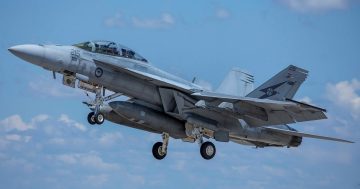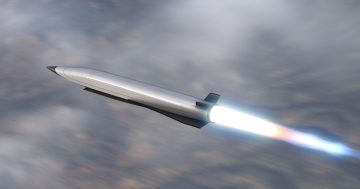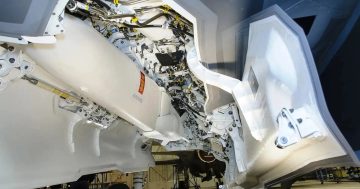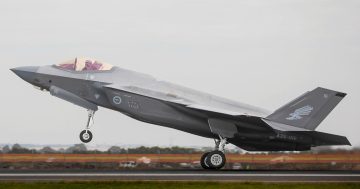
An LRASM is launched from an RAAF F/A-18F during the operational test in February. Photo: ADF.
The Royal Australian Air Force (RAAF) has successfully conducted an operational test of a new anti-ship missile.
The late-February test involved two RAAF F/A-18F Super Hornets, and saw a successful launch of two AGM-158C long-range anti-ship missiles (LRASM) over the Point Mugu sea range off the coast of California, where they successfully struck a barge stacked with containers representing a ship target.
The operational test also included the validation of weapons preparation and loading. It was supported by RAAF E-7A Wedgetail command and control and EA-18G Growler electronic attack aircraft, as well as a US Navy P-8A Poseidon maritime response aircraft.
The operational test confirmed the RAAF is ready to induct the LRASM into operational service, and validated previous launch data obtained by the US Navy in test launches from its own Super Hornets.
The LRASM has an estimated range of more than 400 kilometres, giving the RAAF the ability to strike enemy shipping from well beyond the range of most air defences.
The stealthy missile has a small jet engine and fold-out wings. Using GPS, it flies a pre-determined course to the target area, where it can discriminate between friendly, civilian and enemy ships via a camera sensor and an internal ship outline database.
Defence Minister Richard Marles said capabilities such as the LRASM would help the Australian Defence Force protect against threats to Australia and our national interests.
“These weapon systems equip our forces to better protect Australia’s maritime approaches and, when necessary, conduct operations in our region,” he said.
“It will be seen across the Super Hornet, Poseidon and F-35 fleets.
“The successful firing of the LRASM wouldn’t have been possible without the participation of our allies and industry partners, like the United States and Lockheed Martin.”

An LRASM photographed on the inner-wing pylon of an RAAF Super Hornet. Photo: Screenshot – ADF.
Minister for Defence Industry and Capability Delivery Pat Conroy said the government had prioritised funding capabilities like this to respond to Australia’s strategic circumstances.
“The acquisition of LRASM is a significant step-up in long-range strike for our air force and underscores the Albanese Government’s commitment to equipping the ADF with the capabilities it needs to keep Australians safe,” he said.
The LRASM test was the culmination of a broader RAAF deployment to the US in December, January and February, which also saw Super Hornets, Growlers and a Wedgetail participate in high-fidelity exercises such as Red Flag Nellis 25-1 and Bamboo Eagle 25-1 in Nevada and California. The Growlers conducted test flights with the new AN/ALQ-249(v)1 next-generational jammer pod in California.
The LRASM is being acquired under the RAAF’s Project AIR 3023 Phase 1 Enhanced Maritime Strike requirement, which will see the ageing AGM-84 Harpoon anti-ship missile replaced by the LRASM on the RAAF’s F/A-18Fs, P-8As and F-35As, and the KONGSBERG Joint Strike Missile on the F-35A.
The RAAF has or will operate all three variants of the AGM-158 family, which is built by Lockheed Martin – the 400 km-range AGM-158A JASSM was carried by the now-retired F/A-18A-B classic Hornet fighters, the 800 km-range AGM-158B JASSM-ER has been selected for the F/A-18F Super Hornets, and now the AGM-158C LRASM.











